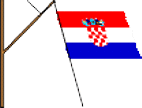Dictionary of Vexillology: G (Gaff – Giton) (original) (raw)
GAFF
A spar rigged at an upward angle from the upper part of a mast or pole, and equipped with a halyard at its highest point from which an ensign is flown when at the peak. A gaff may be fitted to the mizzenmast (or other masts dependent upon the rig) of a sailing ship, or from the mast of a warship (when it will sometimes carry a command flag), or from a mast (or stayed mast) ashore (see also ‘fore’, ‘halyard’, ‘mast’, ‘mizzen’, ‘outrigger pole’, ‘peak’, ‘sailor’s mast’, ‘shift colours’ and ‘stayed mast’).
Notes a) If a gaff is fitted to a flag pole or mast for civilian or naval use ashore, it is generally (but not exclusively) that flag which is used as a naval/civil ensign (or a yacht ensign if appropriate) which is flown from its peak (see also ‘civil ensign’ and ‘yacht ensign’ under ‘ensign’) b) (While underway) non-naval sailing vessels have the option of flying their ensigns for the peak of the gaff if fitted, or from two-thirds the way up the leech of the mainsail if Bermuda rigged (see ‘peak’ and ‘leech’).
GAJARDUS
A medieval term, now obsolete, for the carriage upon which a standard was fixed – a carrocerum (see also ‘standard 6)’ and ‘vexilloid’).
Please note that in the early-middle ages, standards were sometimes (for reasons which are now unclear) transported into battle and displayed whilst mounted on some form of wheeled conveyance.
GALHARDETE
- A Portuguese generic term that covers a number of small flags or pennants (in several, varying types), often given away or sold as souvenirs.
- The term was also used by 19th century French sources to describe Brazilian merchant ship pendants – see �merchant ship pendant�.

Galhardete/Merchant Ship Pendant of Pernambuco, Brazil (fotw)
GALLEON
A three or four-masted sailing vessel of the mid-16th to the early 18th Century (see also caravel, carrack and sailing ship 2)).
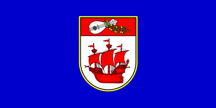
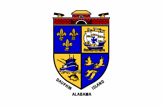
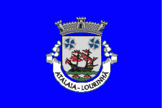
Flag of Dubrovačko, Croatia; Flag of Dauphin Island, U.S.; Flag of Atalaia, Portugal
GALLERY
A bar running at right angles from the staff from which the flag is partially suspended (see also ‘framed flag’ and ‘outrigger flag’).



Flags of Chevel', Pen'kiv, and Holovyn, Ukraine (fotw)
GALLEY
- Generically a ship whose motive power was principally provided by her oars (see also ‘galley ensign’).
- Specifically the heraldic term for an oared warship with more than one mast – but see ‘ancient ship’.
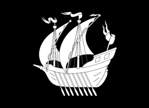

Flag and Arms of Kragerø, Norway
GALLEY ENSIGN
In largely Mediterranean usage, a distinctive ensign or flag now obsolete, that was specifically flown from a warship whose principal motive power came from her oars rather than her sails (see also ‘ensign’ and ‘galley’).
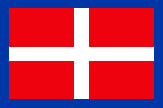
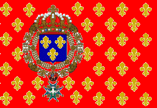
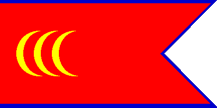
Flag of a Galley Captain, Sardinia 18th Century; Galley Ensign of France 18th Century; Ensign of The Commander of Galleys, Pre-Ottoman Tunis
GALTRAP
An alternative heraldic term to caltrap – see ‘caltrap’.
GARBE (or GARB)
The heraldic term for a sheaf of wheat, corn or other cereal � but see note below.

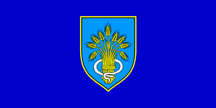
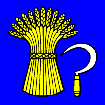
Flag of Worben, Switzerland (fotw); Flag of Sopje, Croatia (fotw); Flag of Freienwil, Switzerland (fotw)
Please note that if a sheaf is made up of any grain other than wheat this must be stated – e.g., a garbe of reeds as on the flag of Worben illustrated above.
GARDAMANO
See ‘handguard’.

A Gardiamo/Handguard According to Spanish Regulations (Reglamento de Banderas Actualizado)
GARDANT
An alternative heraldic term to guardant – see ‘guardant’.
[ ![[example of guardant]](http://www.crwflags.com/fotw/images/v/vxt-d3103.gif) ](../images/v/vxt-d3103.gif)
](../images/v/vxt-d3103.gif)
Flag of Sobrio, Switzerland (fotw)
GARLAND
In heraldry, a term for a closed or almost closed ring consisting of intertwined leaves, or of leaves and flowers – a chaplet or orle (see also ‘wreath 1)’).
On flags as above, but the term is also used to describe an open topped wreath composed of leaves, or of leaves and/or flowers, etc., that does not exceed two-thirds the depth of the object surrounded (for example that on the flag of Parana, Brazil) – or sometimes considerably less – but see ‘crossed branches 1)’ and wreath 1’.
[ ![[garland]](http://www.crwflags.com/fotw/images/v/vxt-d2245.gif) ](../images/v/vxt-d2245.gif) [
](../images/v/vxt-d2245.gif) [ ![[garland]](http://www.crwflags.com/fotw/images/v/vxt-d2780.gif) ](../images/v/vxt-d2780.gif) [
](../images/v/vxt-d2780.gif) [ ![[garland]](http://www.crwflags.com/fotw/images/v/vxt-d153.gif) ](../images/v/vxt-d153.gif)
](../images/v/vxt-d153.gif)
Royal Standard 1961 � 1971, Sierra Leone (fotw); High Commissioner’s Badge, Palestine 1948 (fotw); Flag of Parana, Brazil (fotw)
Please note with regard to 1), that the English heraldic requirement of only four flowers per garland is not generally observed in flags.
[ ![[garland]](http://www.crwflags.com/fotw/images/v/vxt-d2246.gif) ](../images/v/vxt-d2246.gif)
](../images/v/vxt-d2246.gif)
A Garland in Heraldry According to English Heraldic Practice (Parker)
GARNISHED
The heraldic term used when a charge (such as a horn, helmet or mitre, etc.) is decorated or ornamented with details in another tincture – but see ‘adorned 2)’ (also ‘charge 1)’, ‘barbed’, ‘hafted’, ‘hilted’, ‘shafted’ and ‘tincture�).
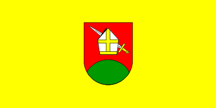

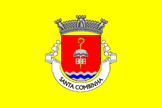
Flag of Martijanec, Croatia (fotw); Flag of Horn, Netherlands (fotw); Flag of Santa Combinha, Portugal (fotw)
GARRISON FLAG
In US usage, the largest of the three standard sizes of national flag flown at army and marine corps posts – 20 x 38 feet or 6.1 x 10.9m (see also ‘post flag 1)’, ‘storm flag’ and ‘war flag’).
Please note that the use of standard sizes of flag at army posts is by no means limited to the US (although the names may differ), and that the largest size is the one displayed on days of national celebration and/or service significance, or as otherwise regulated (see also ‘battle ensign’, ‘ceremonial ensign’, ‘holiday colours’ and ‘Sunday ensign’).
GARVEY COLORS/COLOURS
The colours introduced by Marcus Garvey in 1917 and designed to represent African-American heritage; they were internationally adopted in 1920 and are now used on the national flags Kenya, Malawi and Zambia – the black liberation or Afro-American flag or colours – but see ‘pan-African colours’.
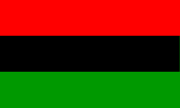
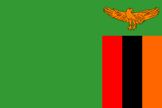
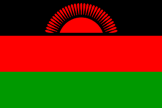
Marcus Garvey’s Flag 1917; National Flag ofZambia; National Flag of Malawi
Please note that some sources include these with the pan-African colours as referenced above.
GAY PRIDE FLAG
See 'rainbow flag 1)'.
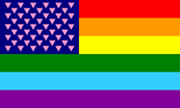
A US Gay Pride Flag (fotw)
GEAR WHEEL
See 'cog-wheel'.
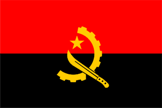
National Flag of Angola (fotw)
GEMEL
An alternative heraldic term to bar – see 'bar 1)'.

Flag of Frelighsburg, Canada (fotw)
GEMMED
- The heraldic term for any gemstone found in a ring’ � stoned.
- In some systems of European heraldry, the term used to describe when an object (such as an orb crown or mitre) is decorated with jewels � but see ‘garnished’.

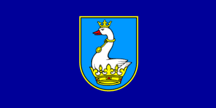

Flag of Lomba da Fazenda, Portugal (fotw); Flag of Posedarje, Croatia (fotw); Flag of Benfica, Portugal (fotw)
GENEVA CONVENTION FLAG
See 'safe conduct flag 1)'.

Flag of the International Red Cross (fotw)
GEORGE CROSS
The symbol of a British order of civilian gallantry granted to Malta (by HM King George VI) in 1942 and appearing on their national flag/naval jack – see augmentation of honour.
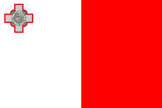
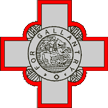
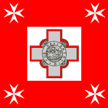
National Flag, enlarged detail and Naval Jack of Malta (fotw)
GIN PENNANT (or PENDANT)
In British RN and some other usage, an unofficial pennant of varying design – now often a defaced version of the starboard pennant in the NATO signalling code – raised when a ship’s officers wish to entertain the officers of another ship or ships (see also ‘pennant 2)’ and ‘senior officer afloat pennant’).
[ ![[Gin Pennant]](http://www.crwflags.com/fotw/images/v/vxt-d505.gif) ](../images/v/vxt-d505.gif)
](../images/v/vxt-d505.gif)
One version of the gin pennant, UK (CS)
Please note that the above is usually made on board from whatever materials lie to hand, however, the company Gordon’s Gin are known to have supplied a number of commercially produced gin pennants to yachtsmen in the 1950’s.
[ ![[commercial Gin Pennant]](http://www.crwflags.com/fotw/images/v/vxt-d505a.gif) ](../images/v/vxt-d505a.gif)
](../images/v/vxt-d505a.gif)
Commercially Produced Gin Pennant c1955, UK (CS)
GIRON (GERONNY, GYRONS or GIRONNÉ)
Alternative heraldic terms for gyronny – see ‘gyronny�.

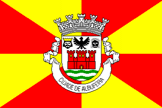
Flag of Warfstermolen, The Netherlands (fotw); Flag of Albufeira, Portugal (fotw)
GITON (GETON or GYTTON)
Alternative medieval terms, now obsolete, used to describe a small (possibly swallow tailed) flag (see also ‘pennant’ and ‘lance pennon 1)’).
Please note that there is no proven connection between these terms and ‘guidon’, but that the similarity cannot be ignored.
Introduction | Table of Contents| Index of Terms | Previous Page | Next Page
